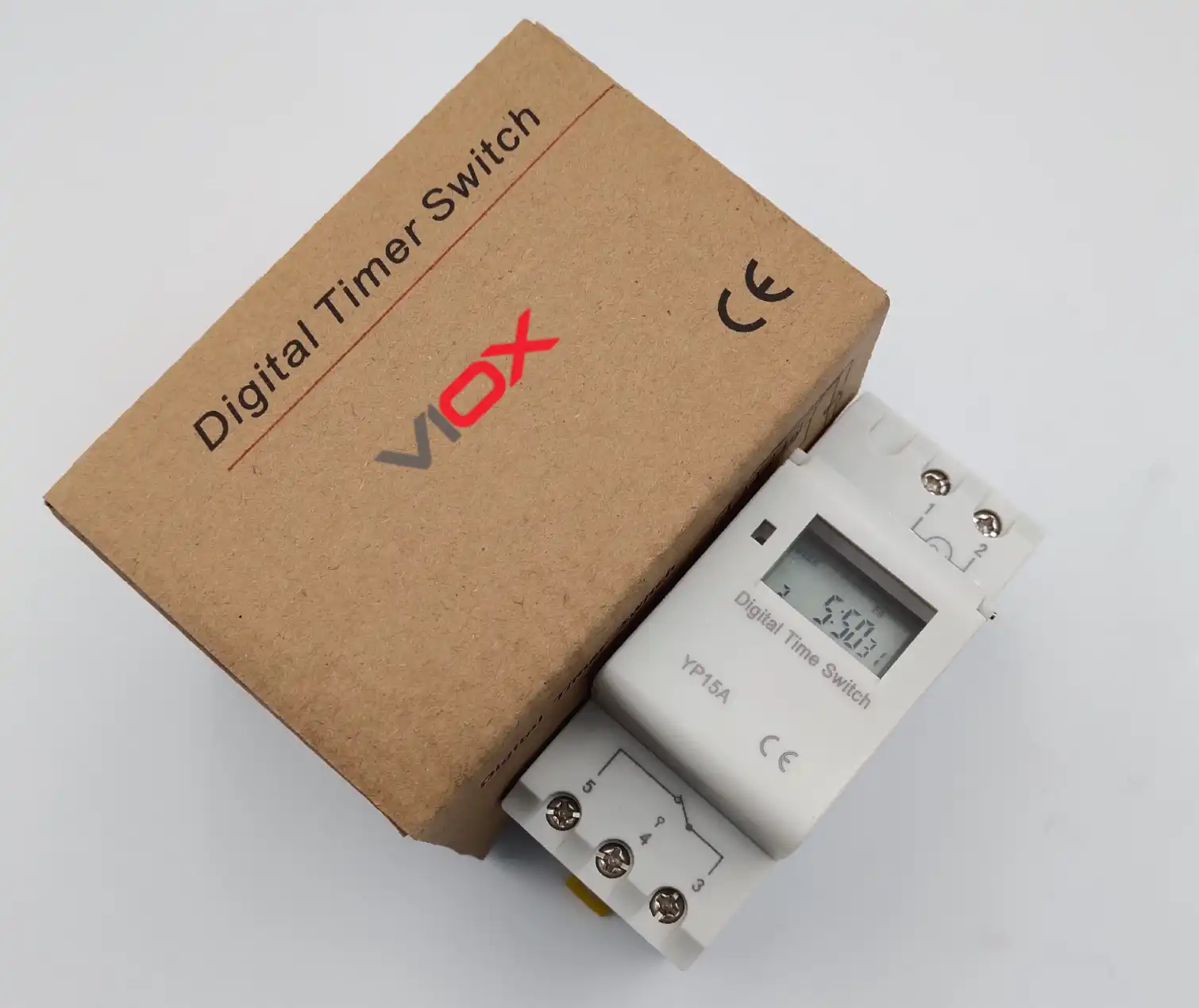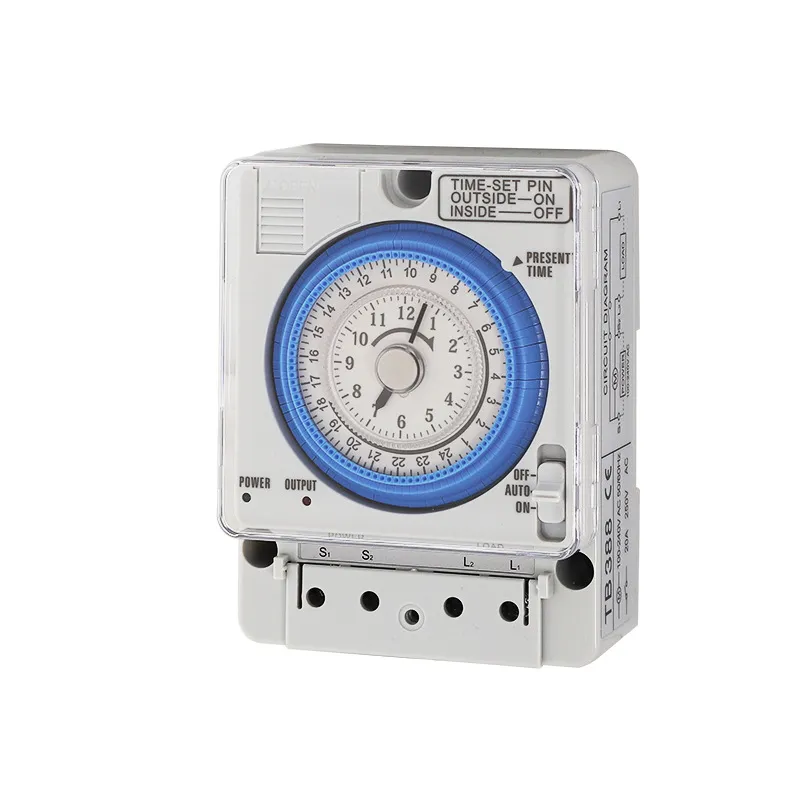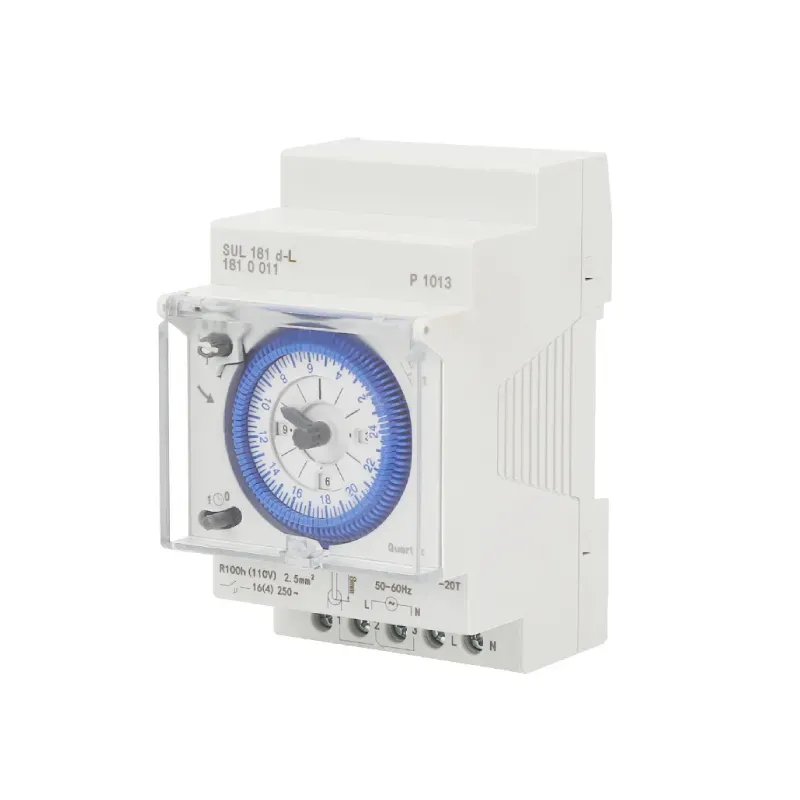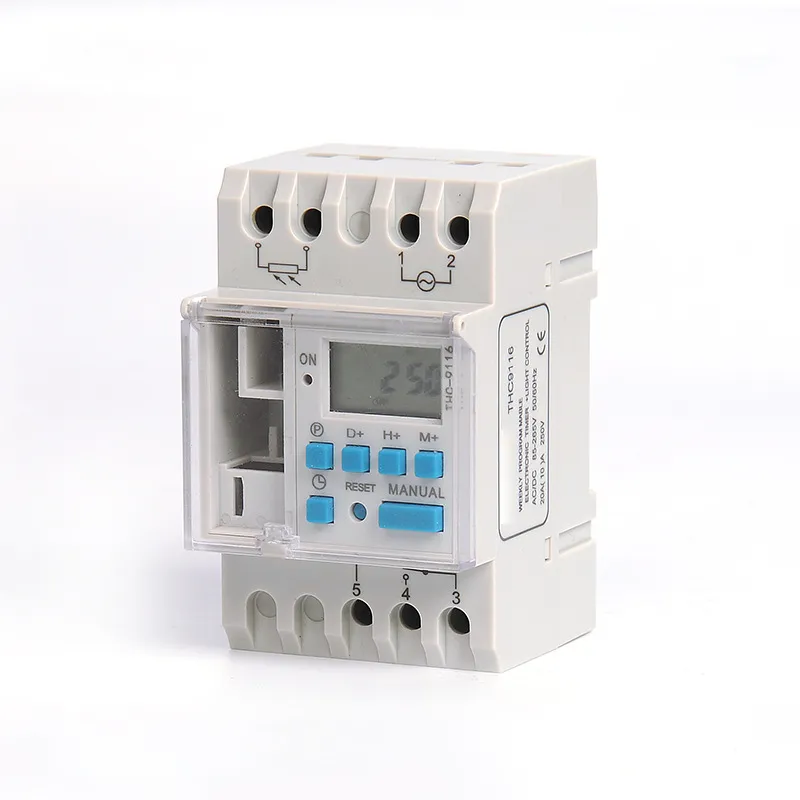Ever walked into a room to find lights blazing that you forgot to turn off hours ago? Or worried about your home’s security while traveling, wishing your lights could turn on and off automatically? You’re not alone. Millions of homeowners struggle with energy waste and security concerns that could be easily solved with the right time switch.
A time switch—also called a timer switch—is an electrical device that automatically controls when your lights, appliances, and other electrical equipment turn on and off. These ingenious devices can slash your energy bills by up to 30%, enhance your home security, and eliminate the daily hassle of manually managing your electrical systems.
In this comprehensive guide, you’ll discover how to choose the right time switch for your specific needs. We’ll explore the four main types available, key selection criteria, installation considerations, and common mistakes to avoid. By the end, you’ll have the knowledge to make an informed decision that saves you money and simplifies your life.
Understanding Time Switches: What They Are and Why You Need One
What is a Time Switch?

අ time switch is an electrical control device that operates by automatically turning circuits on and off according to predetermined schedules. Unlike manual switches that require your physical presence to operate, time switches work independently using either mechanical clockwork mechanisms or electronic programming.
Here’s the thing: these devices serve three primary functions that make them essential for modern homes and businesses. First, they dramatically reduce energy consumption by ensuring lights and appliances only run when needed. Second, they enhance security by creating the illusion of occupancy when you’re away. Third, they provide unmatched convenience by automating routine electrical tasks.
The benefits extend far beyond simple on/off control. Time switches can help you take advantage of off-peak electricity rates, extend the lifespan of your electrical equipment by preventing continuous operation, and even contribute to environmental conservation through reduced energy consumption.
Time Switch vs Timer Switch: The Terminology
You’ll often see these terms used interchangeably, and that’s perfectly correct. “Time switch” and “timer switch” refer to the same category of devices. Some manufacturers prefer one term over the other, and regional preferences exist, but functionally they’re identical.
The key point is that both terms describe devices designed to control electrical circuits based on time parameters, whether that’s a simple countdown function or complex weekly programming schedules.
The 4 Main Types of Time Switches
Mechanical (Analog) Time Switches
Mechanical time switches represent the simplest and most traditional approach to automated electrical control. These devices use physical mechanisms—typically springs, gears, and rotating dials—to track time and operate electrical contacts.
How They Work:
The heart of a mechanical timer is a slowly rotating motor or spring-driven mechanism that turns a dial over a 24-hour period. Small pins or tabs around the dial’s circumference can be pushed down to indicate “on” times and left up for “off” periods. When the rotating dial reaches a depressed pin, it activates the electrical switch.
ප්රධාන වාසි:
– සරල බව: No programming required—just push pins down for desired on times
– විශ්වසනීයත්වය: Fewer electronic components mean fewer potential failure points
– No Power Required: Many models continue operating during power outages
– පිරිවැය-ඵලදායී: Typically the most affordable option, ranging from $12-35
– Easy to Understand: Visual dial makes current settings immediately apparent
සීමාවන්:
– Limited Precision: Usually restricted to 15-30 minute intervals
– Daily Repetition Only: Same schedule repeats every 24 hours
– Maintenance Needs: Moving parts require occasional cleaning and lubrication
– ප්රමාණය: Generally bulkier than electronic alternatives
Best Use Cases:
Mechanical time switches excel in straightforward applications like basic outdoor lighting, simple irrigation systems, or any situation where you need the same daily schedule without variation. They’re particularly valuable in areas prone to power outages or where simplicity is preferred over advanced features.
Digital (Electronic) Time Switches
Digital time switches represent a significant leap forward in functionality and precision. These devices use microprocessors and electronic circuits to provide sophisticated programming capabilities and exact timing control.
Advanced Programming Features:
Modern digital time switches can store multiple program groups, allowing different schedules for weekdays versus weekends. Many models support up to 16 or more separate on/off events daily, with precision down to the minute or even second.
ප්රධාන වාසි:
– Exceptional Precision: Program schedules down to the exact minute
– Multiple Programs: Different settings for weekdays, weekends, holidays
– Flexible Scheduling: Up to dozens of on/off cycles per day
– Memory Backup: Battery backup maintains settings during power outages
– Digital Display: Clear LCD screens show current time and program status
– උසස් විශේෂාංග: Random mode, countdown functions, manual override
සලකා බැලීම්:
– සංකීර්ණත්වය: More features mean more complicated programming
– Power Dependent: Require constant power supply (though battery backup helps)
– ඉහළ පිරිවැය: Typically range from $25-75
– Learning Curve: May require reading manual to utilize all features
කදිම යෙදුම්:
Digital time switches shine in commercial settings, complex residential applications, or anywhere you need different schedules throughout the week. They’re perfect for retail lighting, office buildings, or homes where occupancy patterns vary significantly between weekdays and weekends.
But wait—there’s more to consider when choosing between digital models. Look for features like astronomic capabilities, which automatically adjust for seasonal daylight changes, and random mode settings that vary timing slightly for enhanced security.
Astronomical Time Switches
Astronomical time switches represent specialized digital timers designed specifically for applications that need to coordinate with natural daylight cycles. These sophisticated devices automatically calculate sunrise and sunset times based on your geographical location.
How They Work:
These timers contain built-in databases with sunrise and sunset information. You simply enter your latitude and longitude (or select from preset zones), and the device automatically adjusts its switching times throughout the year. Advanced models even include GPS functionality for completely automatic setup.
ප්රධාන ප්රතිලාභ:
– Automatic Seasonal Adjustment: No need to reprogram as daylight hours change
– Precise Solar Calculations: Accurate to within minutes of actual sunrise/sunset
– Offset Programming: Can be set to activate before or after astronomical events
– Energy Optimization: Maximizes natural light usage, minimizing artificial lighting needs
– Maintenance-Free Operation: Once programmed, requires no seasonal adjustments
Perfect Applications:
– Outdoor Security Lighting: Ensures lights activate exactly when darkness falls
– Landscape Illumination: Coordinates garden and pathway lighting with natural conditions
– Street Lighting: Municipal and commercial outdoor lighting systems
– කෘෂිකාර්මික යෙදුම්: Greenhouse lighting and livestock facility management
Investment Range:
Astronomical time switches typically cost $45-120, reflecting their specialized capabilities and advanced programming features.
Smart/IoT Time Switches
Smart time switches represent the cutting edge of electrical automation, combining traditional timing functions with modern connectivity features. These devices connect to your home’s WiFi network, enabling remote control and integration with broader home automation systems.
Connected Features:
– Smartphone Control: Program and monitor from anywhere using dedicated apps
– Voice Assistant Integration: Compatible with Alexa, Google Assistant, and other platforms
– Remote Monitoring: Check device status and receive notifications
– Energy Tracking: Monitor power consumption and usage patterns
– Integration Capabilities: Connect with other smart home devices for coordinated automation
Advanced Functionality:
Smart time switches often include features like weather-responsive programming, which adjusts schedules based on current conditions, and learning algorithms that optimize energy usage based on your habits.
Investment Considerations:
While smart time switches range from $30-100, their long-term value comes from energy optimization, convenience, and integration with existing smart home ecosystems.
The secret is choosing smart switches that offer genuine utility rather than flashy features you’ll never use. Focus on models with reliable app interfaces, strong security protocols, and compatibility with your existing devices.
Key Factors to Consider When Choosing a Time Switch
Load Capacity and Electrical Requirements
Understanding electrical load requirements is absolutely critical for safe and effective time switch operation. Getting this wrong can result in device failure, fire hazards, or expensive equipment damage.
Understanding Wattage Ratings:
Every time switch has a maximum wattage rating—the total power it can safely control. To calculate your needs, add up the wattage of all devices the switch will control. For example, if you’re controlling five 60-watt bulbs, you need a switch rated for at least 300 watts. However, always include a 20% safety margin, so choose a switch rated for 360 watts or higher.
Voltage Compatibility:
Most residential applications use 120V circuits, while some appliances and commercial applications require 240V. Always verify your circuit voltage before purchasing a time switch. Using the wrong voltage rating can be dangerous and will void warranties.
Current Ratings and Load Types:
Time switches are rated for specific current levels, typically 15A or 20A for residential use. However, the type of load matters significantly:
– ප්රතිරෝධී බර (incandescent bulbs, heaters): Full rated capacity applies
– ප්රේරක බර (motors, transformers): May require derating to 75% of rated capacity
– ධාරිත්රක පැටවීම් (some LED drivers): Can cause startup surges requiring special consideration
LED and CFL Compatibility:
Here’s what most people don’t realize: many time switches aren’t compatible with LED and CFL bulbs. These energy-efficient lights draw very low current, which may be below the minimum load required for proper switch operation. This can cause flickering, shortened bulb life, or timer malfunction.
Solutions for LED/CFL Compatibility:
– Choose timers specifically rated for LED/CFL use
– Ensure minimum load requirements are met
– Consider using a bypass device for very low loads
– Opt for digital timers, which typically handle low loads better than mechanical ones
Neutral Wire Requirements:
Many digital and smart time switches require a neutral wire connection for proper operation. Before purchasing, verify that your electrical box contains a neutral wire (typically white). If no neutral wire is available, look for “no-neutral” compatible models or consider hiring an electrician to run new wiring.
Installation Type and Location
The installation environment significantly impacts which time switch type will work best for your application.
In-Wall Time Switches:
These replace standard wall switches and provide the cleanest, most professional appearance. They’re ideal for permanent installations and new construction. Consider factors like:
– Standard electrical box compatibility
– Available wall space for larger digital displays
– Access for programming and adjustment
– Integration with existing switch plates and décor
Plug-In Timers:
These portable units plug directly into wall outlets, with your device then plugging into the timer. They’re perfect for:
– Temporary or seasonal applications
– Rental properties where permanent installation isn’t allowed
– Table lamps and portable appliances
– Testing timer functionality before permanent installation
DIN Rail Mounted Units:
Designed for electrical panel installation, these industrial-grade timers are ideal for:
– Commercial and industrial applications
– Multi-circuit control
– Central building automation systems
– Applications requiring high current ratings
Outdoor-Rated Applications:
Outdoor installations require special consideration for weather protection. Look for:
– IP65 rating or higher for direct weather exposure
– NEMA enclosures for additional protection
– උෂ්ණත්ව ශ්රේණිගත කිරීම් suitable for your climate
– UV-resistant materials to prevent degradation
Programming Features and Flexibility
The programming capabilities of your time switch should match your actual usage patterns and future needs.
Number of Programs:
Consider how many different on/off events you need daily. Basic applications might need only 2-4 events, while complex commercial settings might require 20 or more. Remember that more programs provide flexibility but also increase complexity.
Weekly vs Daily Programming:
If your schedule varies between weekdays and weekends, weekly programming is essential. Some advanced models offer separate programming for each day of the week, providing maximum flexibility.
Special Modes:
– Random Mode: Varies timing slightly for security applications
– Holiday Mode: Overrides normal programming for special occasions
– අතින් අතික්රමණය කිරීම: Allows temporary control without affecting programmed schedules
– Countdown Mode: Provides simple timer functionality for temporary applications
User Interface Considerations:
The ease of programming can make or break your satisfaction with a time switch. Look for:
– Clear, backlit displays that are easy to read
– Intuitive button layouts and menu systems
– Quick-setup options for common applications
– Comprehensive but understandable instruction manuals
පාරිසරික සලකා බැලීම්
Environmental factors can significantly impact time switch performance and longevity.
Operating Temperature Ranges:
Standard time switches typically operate reliably between 32°F and 104°F (0°C to 40°C). Applications in extreme temperatures—like attics, boiler rooms, or outdoor installations—require units with extended temperature ratings.
Humidity and Moisture Protection:
High humidity environments like bathrooms, laundries, or outdoor applications need switches with appropriate moisture protection. Look for sealed units or those specifically rated for high-humidity use.
Industrial Environmental Factors:
Manufacturing environments may expose time switches to:
– Chemical vapors requiring corrosion-resistant housings
– Vibration necessitating shock-resistant designs
– Dust requiring sealed enclosures
– Electromagnetic interference requiring shielded units
Choosing the Right Time Switch for Specific Applications
Residential Lighting Control
Home lighting represents the most common time switch application, but different areas have varying requirements.
Indoor Lighting Considerations:
For interior applications, focus on convenience and energy savings. Digital time switches work well for living areas where schedules might vary, while simple mechanical timers suffice for utility areas with consistent needs.
Outdoor and Security Lighting:
Bottom line: security lighting demands reliability above all else. Consider these strategies:
– Astronomical timers for seasonal adjustment without maintenance
– Random mode programming to simulate occupancy naturally
– අතින් අභිබවා යාමේ හැකියාව for immediate control when needed
– Battery backup to maintain operation during power outages
Energy-Saving Strategies:
– Program lights to turn off during peak daylight hours
– Use shorter durations in low-traffic areas
– Coordinate multiple switches to avoid overlapping coverage
– Consider occupancy sensors in combination with timers for maximum efficiency
HVAC and Climate Control
Heating and cooling systems present unique challenges for time switch applications due to their high power requirements and operational characteristics.
Load Requirements:
HVAC equipment often requires high-current switches, sometimes 30A or more for large systems. Additionally, motor loads create startup surges that must be considered in switch selection.
Scheduling Strategies:
– Setback Programming: Reduce heating/cooling during unoccupied hours
– Pre-Conditioning: Start systems before occupancy for immediate comfort
– Seasonal Programming: Different schedules for heating and cooling seasons
– Integration Opportunities: Coordinate with other building systems for optimal efficiency
Industrial and Commercial Applications
Commercial and industrial environments demand robust, reliable time switches capable of handling demanding conditions.
Heavy-Duty Requirements:
– High current ratings for motor loads and large lighting systems
– Sealed enclosures for harsh environments
– Extended temperature ratings for extreme conditions
– කම්පන ප්රතිරෝධය for mechanical environments
Multi-Channel Control:
Many commercial applications benefit from time switches that can control multiple circuits independently, allowing coordinated but flexible operation of different systems.
Maintenance Considerations:
Choose switches with:
– Accessible programming interfaces for easy schedule changes
– තත්ව දර්ශක for quick operational verification
– ශක්තිමත් ඉදිකිරීම් to minimize maintenance requirements
– පහසුවෙන් ලබා ගත හැකි ආදේශක කොටස් for long-term support
Garden and Irrigation Systems
Landscape and irrigation applications often combine outdoor environmental challenges with precise timing requirements.
Weather Resistance Needs:
Garden applications require switches that can withstand:
– Direct sunlight and UV exposure
– Temperature extremes from summer heat to winter cold
– Moisture from rain, irrigation, and humidity
– Dirt and debris from normal garden operations
Seasonal Programming Benefits:
Astronomical time switches excel in garden applications by automatically adjusting to seasonal daylight changes. This ensures landscape lighting activates at optimal times year-round without constant reprogramming.
Water Conservation Features:
For irrigation applications, look for switches offering:
– Multiple daily cycles for efficient watering schedules
– Seasonal adjustment capabilities for varying water needs
– Rain delay functions (in advanced models) to skip watering during wet weather
– Zone control for different plant and area requirements
ස්ථාපනය සහ රැහැන් ඇදීම සලකා බැලීම්
DIY vs Professional Installation
Determining whether to install your time switch yourself or hire a professional depends on several factors.
DIY-Friendly Installations:
– Plug-in timers: Simply plug in and program
– Direct switch replacement: If existing wiring is adequate and you have basic electrical knowledge
– අඩු වෝල්ටීයතා යෙදුම්: Generally safer for DIY installation
Professional Installation Recommended:
– New circuit installation: Adding circuits requires electrical expertise
– අධි-ධාරා යෙදුම්: Motors, heaters, and large lighting systems
– Three-way switch conversions: Complex wiring configurations
– එළිමහන් ස්ථාපනයන්: Weather protection and GFCI requirements
– කේතය අනුකූල ප්රශ්න: Local electrical codes vary and require expertise
Common Wiring Scenarios
Understanding basic wiring configurations helps you select compatible time switches and plan installations effectively.
Single-Pole Installations:
The most common residential scenario involves replacing a standard single-pole switch. This typically requires:
– Hot wire connection (usually black)
– Switched leg to the load (often black or red)
– උදාසීන වයරය (white) for many digital switches
– Ground wire (green or bare copper) for safety
Three-Way Switch Configurations:
Controlling lights from multiple locations requires special three-way compatible time switches. These installations are more complex and often benefit from professional installation.
GFCI Protection Requirements:
Outdoor and wet location installations typically require Ground Fault Circuit Interrupter (GFCI) protection. This may be provided by:
– GFCI breakers in the electrical panel
– GFCI outlets upstream of the timer
– GFCI-integrated time switches for direct protection
Top Brands and What to Look For
Leading Manufacturers
Several manufacturers have established reputations for quality and reliability in the time switch market.
Intermatic:
The industry standard for mechanical and basic electronic time switches. Known for robust construction and wide product selection. Their mechanical switches are virtually bulletproof and remain the gold standard for simple applications.
VIOX ELECTRIC:
Focuses heavily on residential applications with user-friendly designs. Their switches often feature intuitive programming and attractive faceplates that integrate well with home décor.
හනිවෙල්:
Strong in smart and connected devices, offering excellent integration with home automation systems. Their products typically feature advanced programming capabilities and reliable smartphone apps.
GE (now Savant):
Reliable performance across a wide range of applications. Known for good value and straightforward operation without unnecessary complexity.
ගුණාත්මක දර්ශක
When evaluating time switch brands and models, look for these quality indicators:
– UL ලැයිස්තුගත සහතිකය ආරක්ෂක අනුකූලතාව සඳහා
– ශක්තිමත් ඉදිකිරීම් with quality materials and solid feel
– Clear documentation with comprehensive installation and programming guides
– Customer support availability for troubleshooting and technical questions
– වගකීම් ආවරණය of at least one year, preferably longer
Warranty and Support Considerations
Time switch warranties typically range from one to five years. However, warranty length isn’t everything—consider:
– Warranty coverage scope: What components and failure types are covered?
– Replacement process: How easy is it to obtain warranty service?
– Customer support quality: Are technical support representatives knowledgeable and helpful?
– Replacement part availability: Can you obtain parts for repairs after warranty expiration?
Budget Considerations and Value Assessment
වර්ගය අනුව මිල පරාසයන්
Understanding typical pricing helps set realistic expectations and identify good values.
Basic Mechanical Timers: $12-35
– Simple daily programming
– Reliable mechanical operation
– Minimal features but proven performance
Digital Programmable: $25-75
– Advanced programming capabilities
– Multiple schedules and special modes
– LCD displays and user-friendly interfaces
Astronomical Timers: $45-120
– Automatic seasonal adjustment
– Precise solar calculations
– Specialized outdoor lighting features
Smart/Connected Switches: $30-100
– WiFi connectivity and app control
– Integration with home automation systems
– Advanced features like energy monitoring
Long-term Value Calculation
The true cost of a time switch extends far beyond the initial purchase price.
Energy Savings Potential:
A quality time switch can reduce lighting energy consumption by 20-40% through optimized scheduling. For a typical home spending $150 monthly on electricity, this represents $30-60 annual savings—enough to pay for most time switches within the first year.
Durability Considerations:
Higher-quality switches typically last 10-15 years or more, while bargain units might require replacement every 3-5 years. Factor replacement costs and installation labor into your value assessment.
Feature Value Assessment:
Pay for features you’ll actually use. Advanced programming capabilities are valuable if you need them, but unnecessary complexity adds cost without benefit for simple applications.
වළක්වා ගත යුතු පොදු වැරදි
Sizing and Compatibility Issues
Overloading Switches:
The most dangerous mistake is exceeding the switch’s rated capacity. Always calculate total connected load and include a safety margin. Remember that motor starting currents can be 3-5 times running current.
Voltage Mismatches:
Using a 120V switch on a 240V circuit (or vice versa) can be catastrophic. Always verify circuit voltage before installation.
LED Compatibility Problems:
Many traditional switches can’t handle the low current draw of LED bulbs, causing flickering or premature failure. Verify LED compatibility before purchasing.
Installation Errors
Neutral Wire Oversight:
Many digital switches require neutral wire connections that aren’t present in older electrical boxes. Verify wire availability before purchasing switches that require it.
Improper Mounting:
Inadequate support or incorrect mounting can lead to mechanical stress and premature failure. Follow manufacturer installation instructions carefully.
Safety Violations:
Always turn off power at the breaker before installation work. Use appropriate safety equipment and follow local electrical codes. When in doubt, hire a qualified electrician.
Making Your Final Decision
Decision Framework
Use this systematic approach to select the right time switch:
1. Define Your Requirements:
– What equipment will you control?
– What scheduling flexibility do you need?
– What’s your budget range?
– Do you need special features?
2. Assess Your Installation:
– What type of installation is required?
– What wiring is available?
– Are there environmental considerations?
– Will you install it yourself or hire a professional?
3. Evaluate Options:
– Compare models meeting your basic requirements
– Consider long-term value, not just initial cost
– Read reviews from actual users
– Verify warranty and support availability
4. Make Your Selection:
– Choose based on needs, not features
– Select from reputable manufacturers
– Ensure proper sizing and compatibility
– Plan for proper installation
Where to Buy and What to Look For
Reputable Retailers:
– Electrical supply houses: Best selection and expert advice
– Home improvement stores: Good for basic residential models
– Online retailers: Competitive pricing but verify return policies
– Specialty automation dealers: Best for smart and advanced systems
Purchase Considerations:
– Return policy: Ensure you can return incompatible units
– තාක්ෂණික සහාය: Verify support availability before purchase
– Installation services: Some retailers offer professional installation
– Bulk pricing: Consider multiple-unit discounts for large projects
නිගමනය
Choosing the right time switch doesn’t have to be overwhelming when you understand the key factors involved. Start by clearly defining your needs: what you want to control, how complex your scheduling requirements are, and what your budget allows.
For simple applications with consistent daily schedules, mechanical time switches offer reliable, cost-effective operation. When you need flexibility and advanced features, digital programmable switches provide excellent value and capabilities. Outdoor lighting benefits tremendously from astronomical switches that adjust automatically for seasonal changes. Smart switches make sense when you want integration with home automation systems or remote control capabilities.
Remember that proper sizing for your electrical load is crucial for safety and performance. When in doubt about electrical requirements or installation procedures, consult with a qualified electrician. The small investment in professional advice can prevent costly mistakes and ensure safe, reliable operation.
The right time switch will serve you reliably for many years while reducing energy costs, enhancing security, and providing daily convenience. Take time to assess your needs carefully, and you’ll find the perfect solution for your specific application.
Ready to start saving energy and simplifying your life? Use the decision framework in this guide to identify your ideal time switch, and take the first step toward smarter electrical control in your home or business.
ආශ්රිත
වීදි ලාම්පු සඳහා කාල ස්විචය සකසන්නේ කෙසේද?
පොදු ටයිමර් ස්විච් රැහැන් ක්රම








